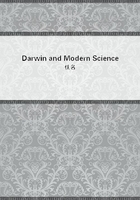
第24章
Much has been written on both sides of this question since the published controversy on the subject in the nineties between Herbert Spencer and myself. I should like to return to the matter in detail, if the space at my disposal permitted, because it seems to me that the arguments I advanced at that time are equally cogent to-day, notwithstanding all the objections that have since been urged against them. Moreover, the matter is by no means one of subordinate interest; it is the very kernel of the whole question of the reality and value of the principle of selection. For if selection alone does not suffice to explain "HARMONIOUS ADAPTATION" as Ihave called Spencer's COADAPTATION, and if we require to call in the aid of the Lamarckian factor it would be questionable whether selection could explain any adaptations whatever. In this particular case--of worker bees --the Lamarckian factor may be excluded altogether, for it can be demonstrated that here at any rate the effects of use and disuse cannot be transmitted.
But if it be asked why we are unwilling to admit the cooperation of the Darwinian factor of selection and the Lamarckian factor, since this would afford us an easy and satisfactory explanation of the phenomena, I answer:
BECAUSE THE LAMARCKIAN PRINCIPLE IS FALLACIOUS, AND BECAUSE BY ACCEPTING ITWE CLOSE THE WAY TOWARDS DEEPER INSIGHT. It is not a spirit of combativeness or a desire for self-vindication that induces me to take the field once more against the Lamarckian principle, it is the conviction that the progress of our knowledge is being obstructed by the acceptance of this fallacious principle, since the facile explanation it apparently affords prevents our seeking after a truer explanation and a deeper analysis.
The workers in the various species of ants are sterile, that is to say, they take no regular part in the reproduction of the species, although individuals among them may occasionally lay eggs. In addition to this they have lost the wings, and the receptaculum seminis, and their compound eyes have degenerated to a few facets. How could this last change have come about through disuse, since the eyes of workers are exposed to light in the same way as are those of the sexual insects and thus in this particular case are not liable to "disuse" at all? The same is true of the receptaculum seminis, which can only have been disused as far as its glandular portion and its stalk are concerned, and also of the wings, the nerves tracheae and epidermal cells of which could not cease to function until the whole wing had degenerated, for the chitinous skeleton of the wing does not function at all in the active sense.
But, on the other hand, the workers in all species have undergone modifications in a positive direction, as, for instance, the greater development of brain. In many species large workers have evolved,--the so-called SOLDIERS, with enormous jaws and teeth, which defend the colony,--and in others there are SMALL workers which have taken over other special functions, such as the rearing of the young Aphides. This kind of division of the workers into two castes occurs among several tropical species of ants, but it is also present in the Italian species, Colobopsis truncata.
Beautifully as the size of the jaws could be explained as due to the increased use made of them by the "soldiers," or the enlarged brain as due to the mental activities of the workers, the fact of the infertility of these forms is an insurmountable obstacle to accepting such an explanation.
Neither jaws nor brain can have been evolved on the Lamarckian principle.
The problem of coadaptation is no easier in the case of the ant than in the case of the Giant Stag. Darwin himself gave a pretty illustration to show how imposing the difference between the two kinds of workers in one species would seem if we translated it into human terms. In regard to the Driver ants (Anomma) we must picture to ourselves a piece of work, "for instance the building of a house, being carried on by two kinds of workers, of which one group was five feet four inches high, the other sixteen feet high."("Origin of Species" (6th edition), page 232.)Although the ant is a small animal as compared with man or with the Irish Elk, the "soldier" with its relatively enormous jaws is hardly less heavily burdened than the Elk with its antlers, and in the ant's case, too, a strengthening of the skeleton, of the muscles, the nerves of the head, and of the legs must have taken place parallel with the enlargement of the jaws. HARMONIOUS ADAPTATION (coadaptation) has here been active in a high degree, and yet these "soldiers" are sterile! There thus remains nothing for it but to refer all their adaptations, positive and negative alike, to processes of selection which have taken place in the rudiments of the workers within the egg and sperm-cells of their parents. There is no way out of the difficulty except the one Darwin pointed out. He himself did not find the solution of the riddle at once. At first he believed that the case of the workers among social insects presented "the most serious special difficulty" in the way of his theory of natural selection; and it was only after it had become clear to him, that it was not the sterile insects themselves but their parents that were selected, according as they produced more or less well adapted workers, that he was able to refer to this very case of the conditions among ants "IN ORDER TO SHOW THE POWER OFNATURAL SELECTION" ("Origin of Species", page 233; see also edition 1, page 242.). He explains his view by a simple but interesting illustration.